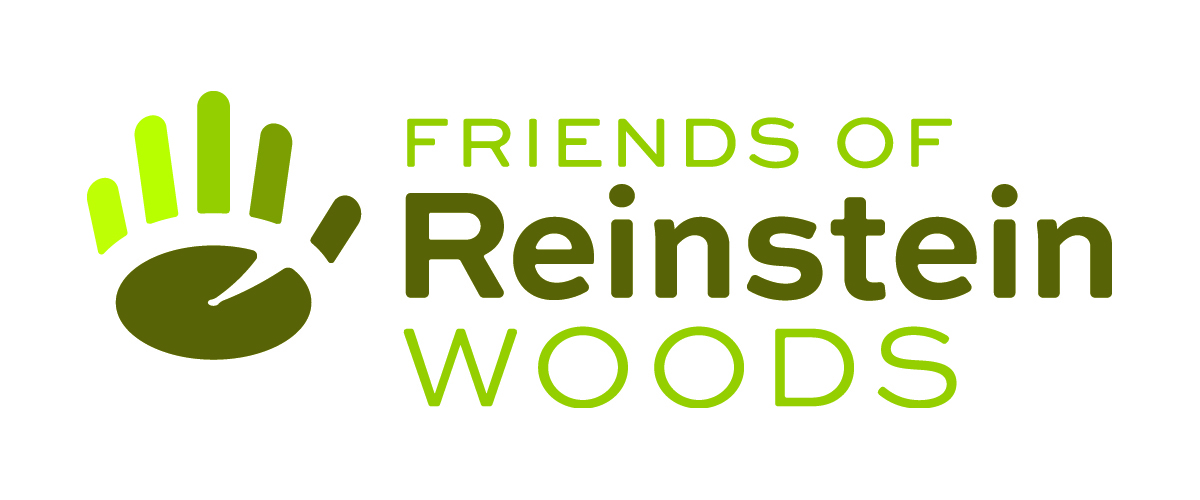Tag Archives: NYSDEC
National EE Week Part 3: Turtles!
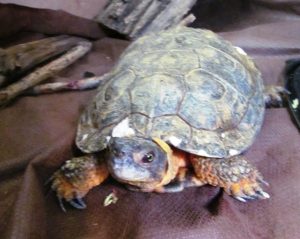
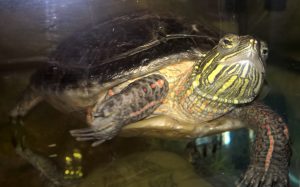
Meet Clementine and Clover, Reinstein Woods’ newest permanent residents! After their owner passed away, these turtles were found under a rug in a home in Clarence. Because both of these turtles are native to New York State, it is illegal to possess them without a permit. Because they had been living in captivity for an unknown period of time, it was not safe to release them into the wild. Thus Reinstein Woods adopted them to serve as ambassadors for their species.
Clover is a female painted turtle. (To identify the sex of a turtle, look at the shape of the bottom shell—flat for females; concave for males).
Named for the yellow and red markings on their head, legs and edge of their shell, painted turtles are the most common turtle at Reinstein Woods. The lower shell of Clover has a dark central blotch, which indicates she is a subspecies called the Midland painted turtle. (The Eastern painted turtle has no mark).
On a walk through Reinstein Woods, look for “shiny black rocks” on logs laying in Lily Pond and Green Heron Pond. Those “rocks” are actually painted turtles basking in the sun. Sometimes the turtles will stack right on top of each other!
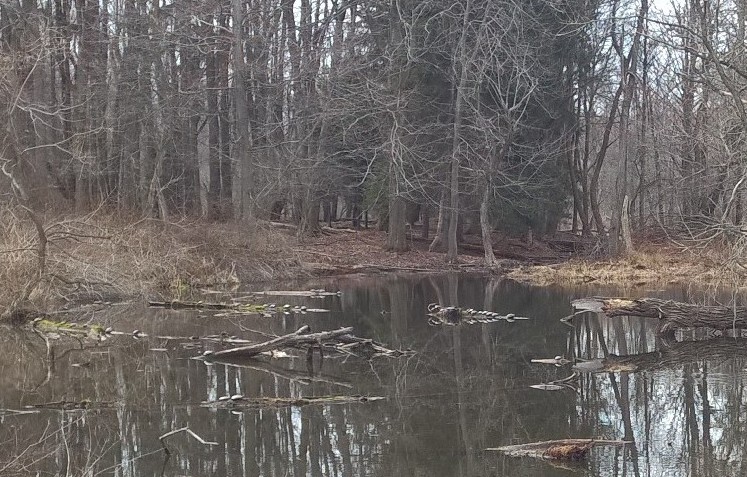
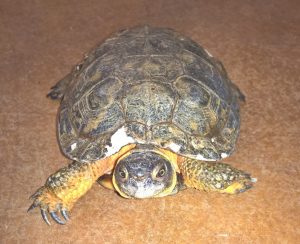
Clementine is a wood turtle. Wood turtles take their name from their preferred woodland habitat, as well as the prominent rings (annuli) on their back that remind some of wood. These colorful turtles spend most of their time wandering the woods along the edge of streams, searching for berries, mushrooms, insects, worms, and small aquatic creatures to eat.
Wood turtles are a Species of Special Concern in New York State. “Special Concern” means an animal could become threatened or endangered in the future due to several factors. In the case of wood turtles, habitat destruction is a major concern. Records from the herp atlas, an effort to identify where reptiles and amphibians live in New York State, indicate that wood turtles are uncommon in most of Western New York, but have a broader distribution downstate. To learn about efforts to help wood turtles deal with habitat disturbance downstate, check out the “Tiny Turtle Bridges” video from NPR’s Science Friday.
And be sure to stop by the Reinstein Woods’ classroom to meet Clementine and Clover on your next visit to Reinstein Woods!
National EE Week Part 2: Nature’s Engineers
A spider, a beaver and a caddisfly walk into a bar….
It sounds like the start of a bad joke, but these animals do actually have something in common: they all are incredible builders, capable of making amazing homes for themselves.
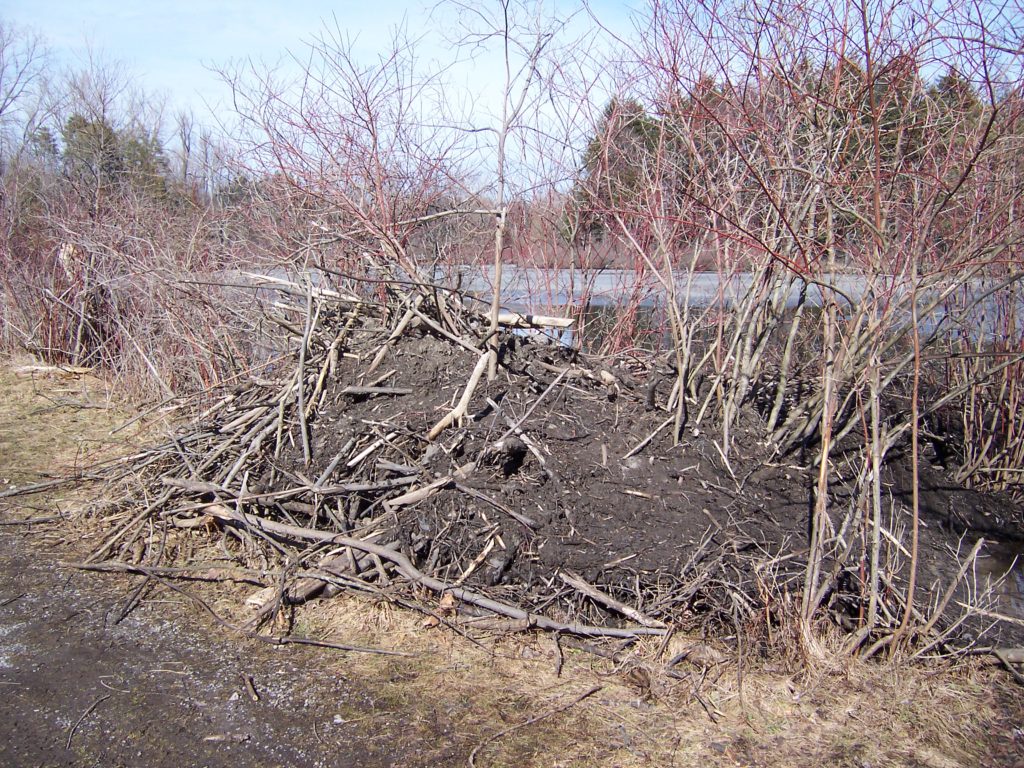
The beaver lodge at Reinstein Woods is one of the most popular stops on a trip around the Lily Pond. This pile of sticks and mud may appear random, but the beavers know how to build a house that provides them with protection from predators and the weather- even in the deepest winter, it provides both a constant temperature and adequate ventilation to sustain the life inside. 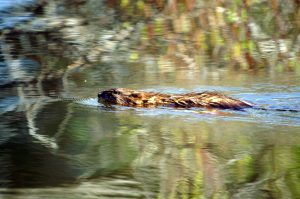
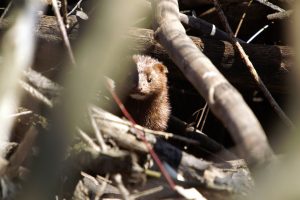
The lodge provides habitat not just for beaver, but also for other animals: snakes can often be found basking in the sun atop the lodge; Canada geese may nest on top of it, and mink are frequent visitors.
More important than their lodge home, the dams built by beavers create wetlands that sustain a variety of wildlife, making them one of only three species that can create completely new habitats capable of sustaining a variety of organisms (can you name the other two?).
You can explore the woods and learn about some of the other master builders (including spiders and caddisflies) living in Reinstein Woods at “Nature’s Engineers,” a walk and talk at 10:30 a.m. on Saturday, April 23. To register, call (716) 683-5959.
National EE Week Part 1: Scavengers!
Happy National Environmental Education Week! Reinstein Woods is excited to be part of this national effort that encourages and celebrates environmental learning across the United States. To celebrate, this week we’ll be highlighting some interesting nature sightings and activities at Reinstein Woods!
Recently a deer passed away in Reinstein Woods, we think after being hit by a car. Since in nature everyone is someone else’s lunch, we were curious who would visit the carcass. Naturalist Intern Heather Rutherford mounted a trail camera at the site of the carcass and recorded the visitors over four days in early March. The camera revealed visitors that you are likely to see on a stroll through Reinstein Woods, and also more reclusive creatures that call Reinstein Woods home.
The first visitor was a red-tailed hawk. The most common hawk in New York State, the red-tailed hawk is often seen sitting on telephone posts along roads, searching for small mammals in the grass below. This raptor will take advantage of carrion like this fresh deer. 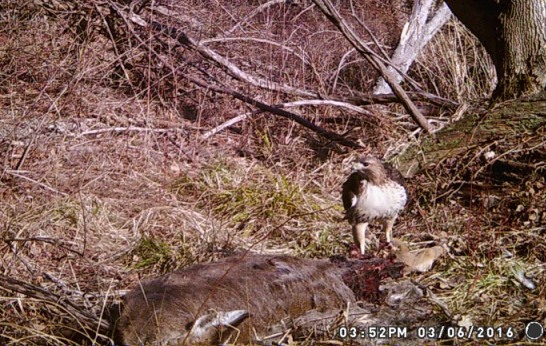
This or a different hawk visited the carcass on each of three successive days, showing off the red tail that gives it its name. 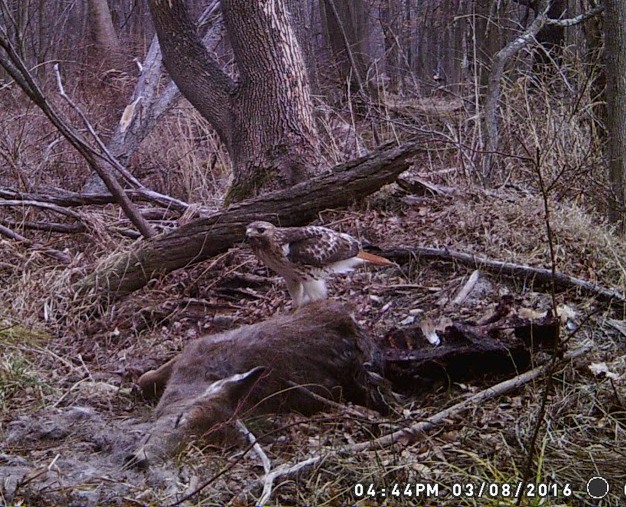
The next visitor was a white-tailed deer who may have wandered in out of curiosity, or just by chance.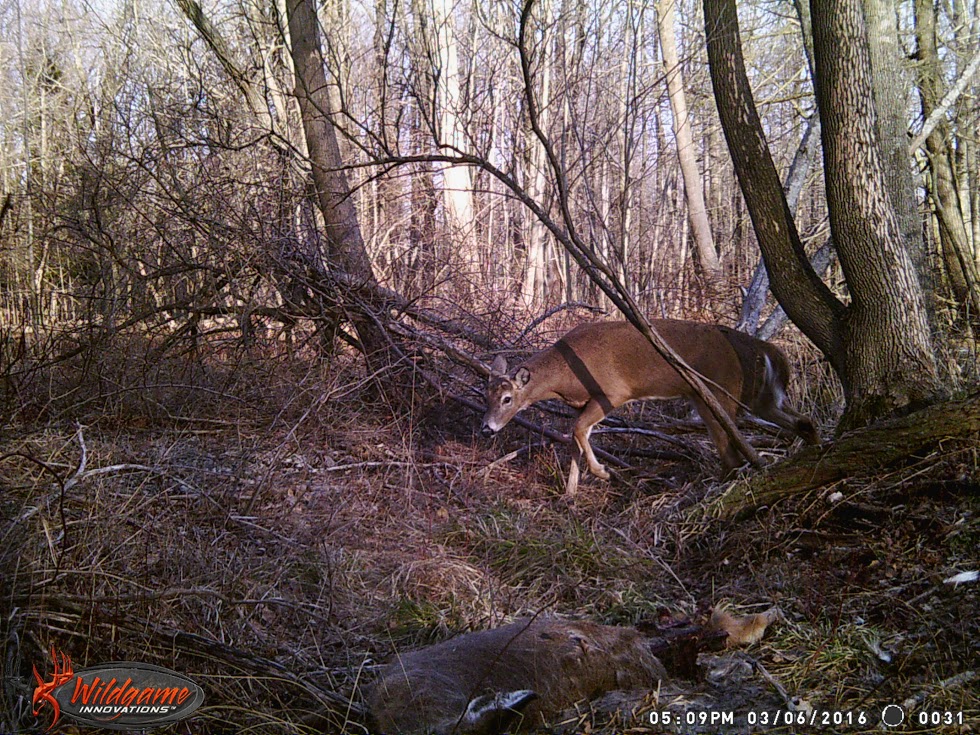 While white-tailed deer are most active at dawn and dusk, their abundant local population makes them a frequent sighting on walks through Reinstein Woods.
While white-tailed deer are most active at dawn and dusk, their abundant local population makes them a frequent sighting on walks through Reinstein Woods.
Within a couple of hours, a coyote appeared on camera. These much misunderstood animals live at Reinstein Woods but are seldom seen. They will scavenge on deer carcasses but don’t often kill adult deer, preferring instead to hunt for smaller animals like rabbits, mice, voles, and other small mammals. They will eat insects and berries at certain times of year as well. (Humans are not on their list of preferred dinner items).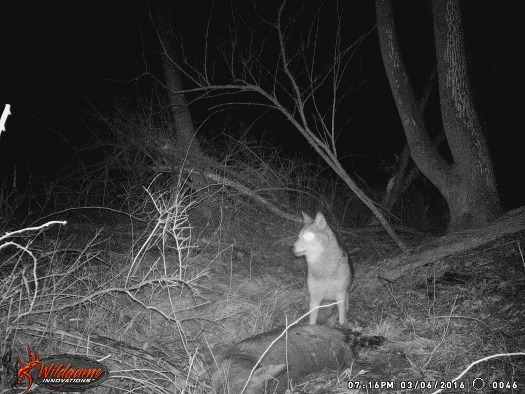
The coyote stuck around for only a few minutes on this first visit, but as soon as the coyote was finished with its snack, a red fox stepped in for a meal (note the time on the photo below).
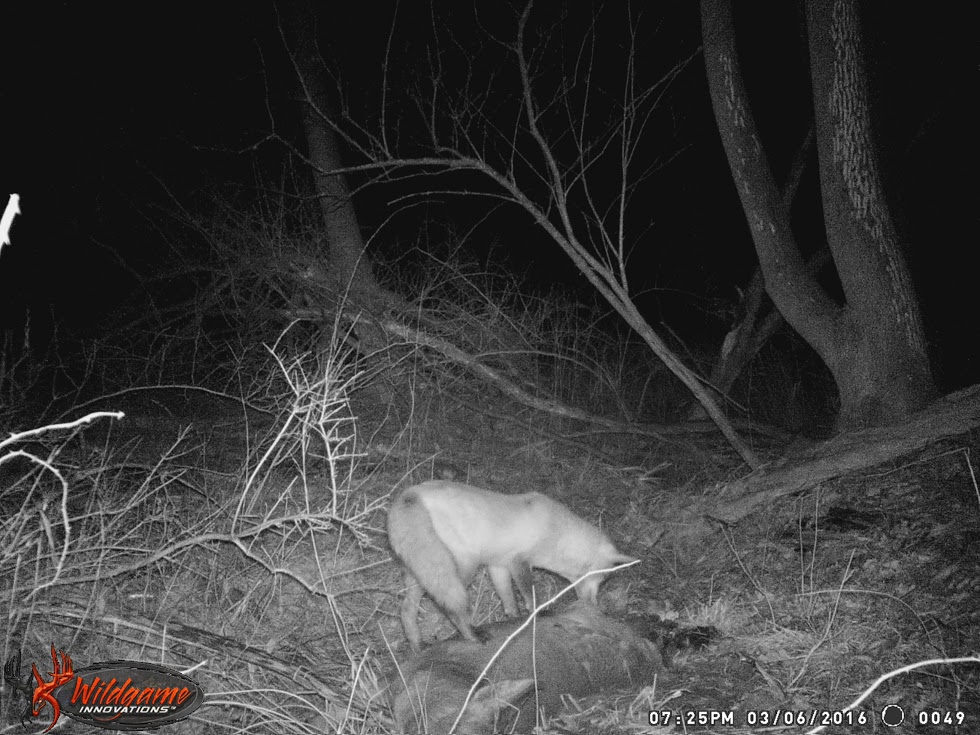
These smaller members of the canine family will also feed on a dead carcass, but their diet mainly consists of small mammals, birds, eggs and fruit. Fox enjoy the mix of habitats provided by suburban neighborhoods, so it is not unusual to encounter one at twilight at Reinstein Woods or to spot one in the surrounding neighborhood.
Over the next couple of days, the camera captured several visits by coyote and red fox. Interestingly, in the early hours of March 9, a fox was enjoying a meal…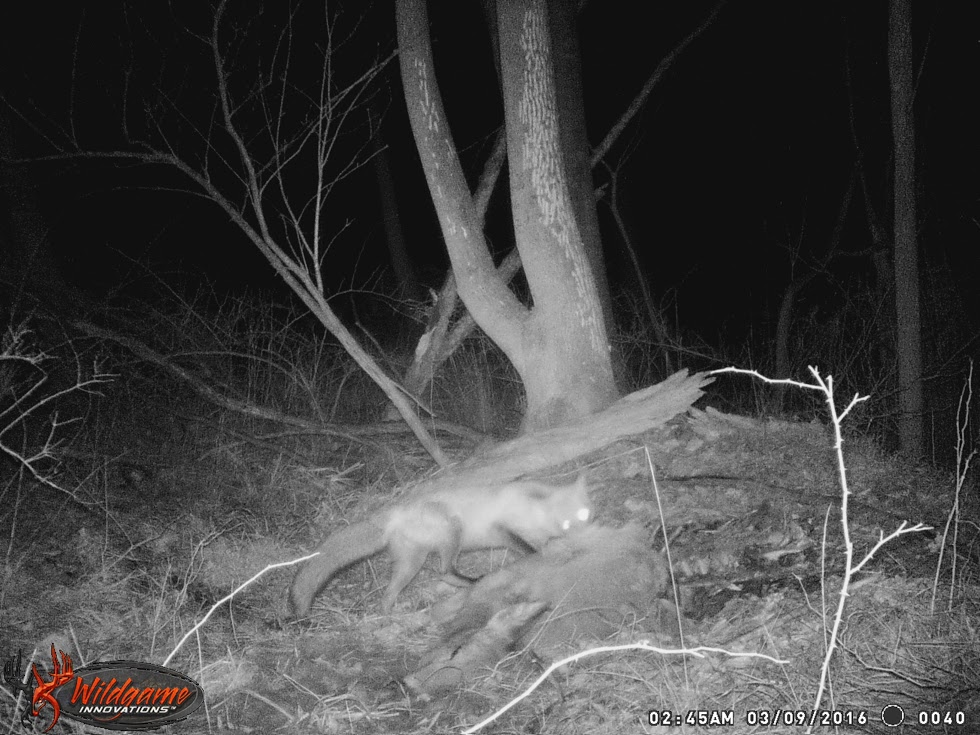
When it was interrupted by not one…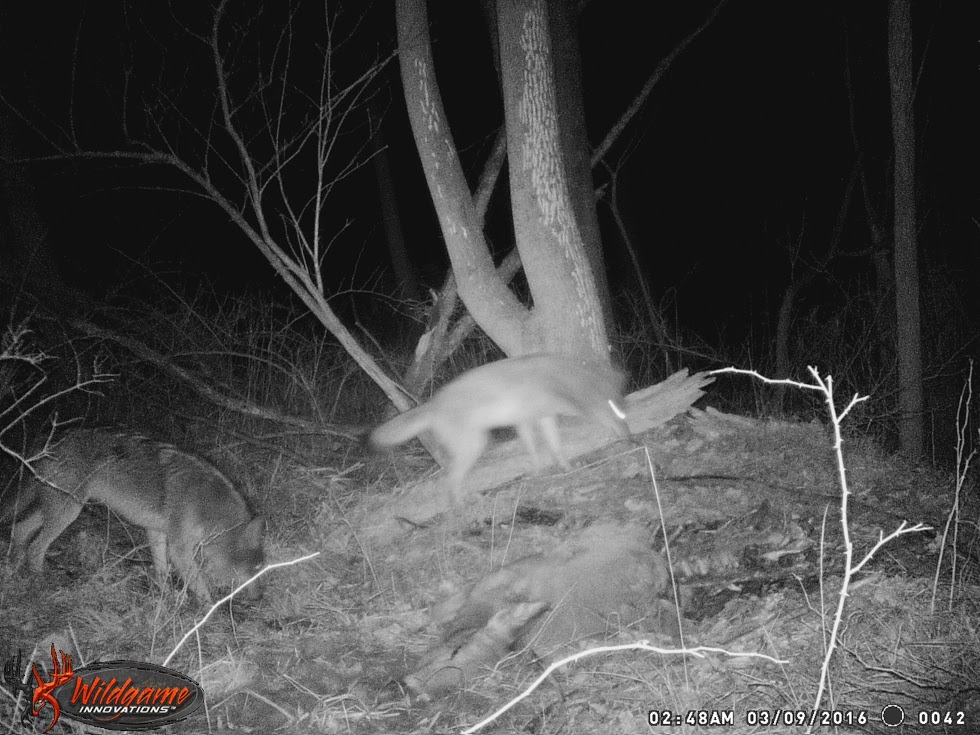
but two coyotes!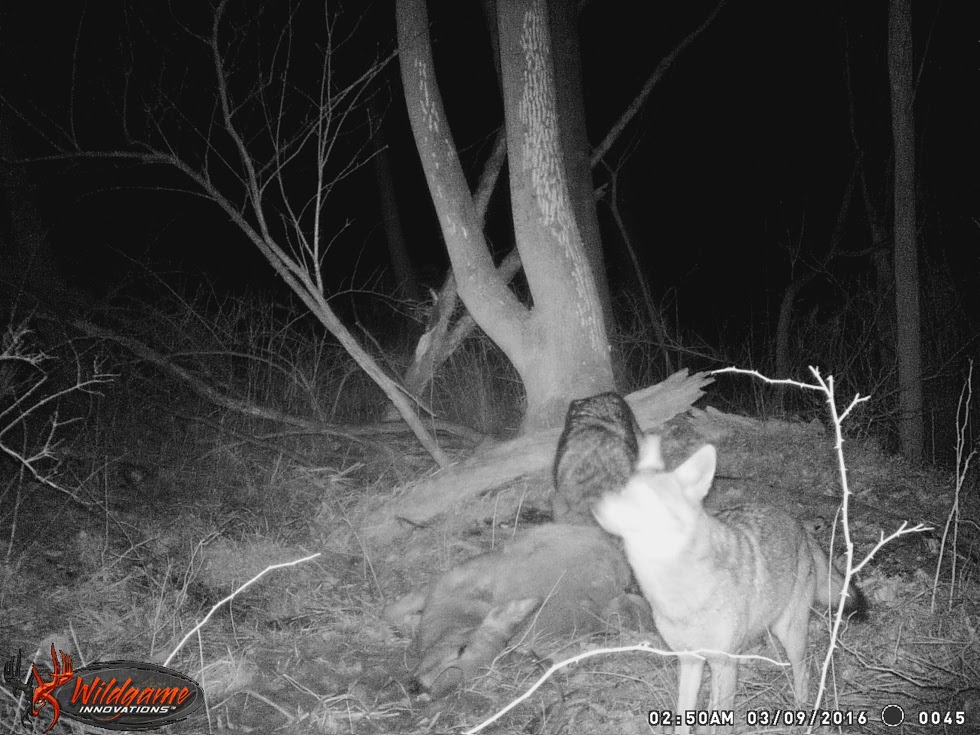
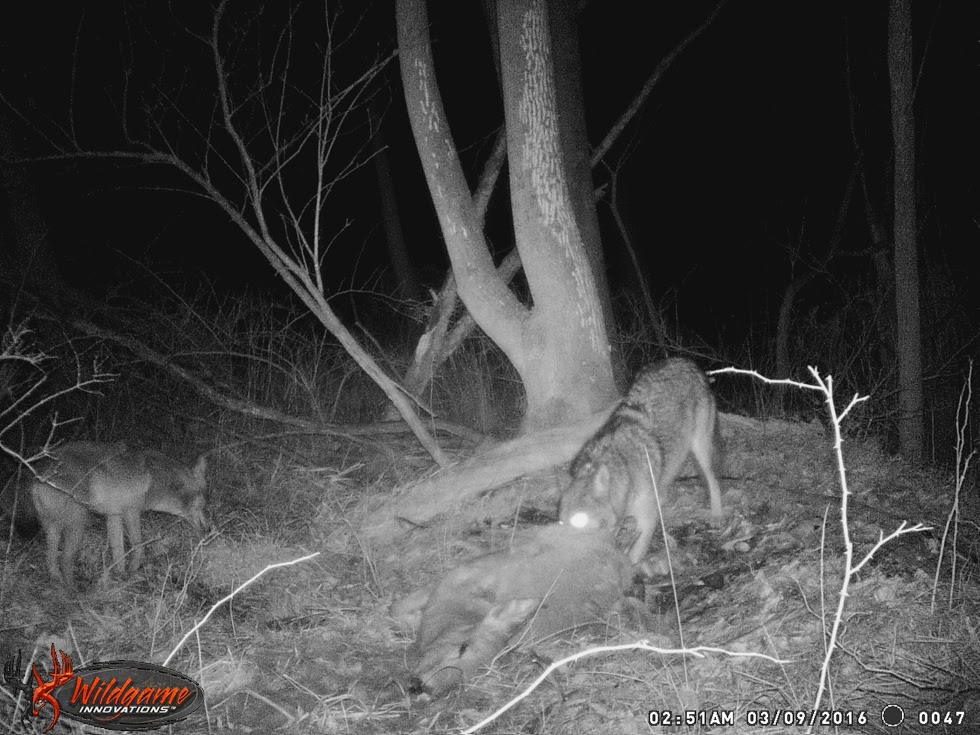
Friends and DEC join Forces to Combat Invasive Common Reed
Thanks to a grant from the New York Power Authority, Friends of Reinstein Woods will be beginning a two-year effort to control common reed in some portions of Reinstein Woods. Common reed, also known by its Latin name Phragmites australis, is an aggressive species that is impacting cattail marshes in the southern half of Reinstein Woods.
A certified pesticide applicator will cut stems and directly apply chemicals to the plants in early fall, when the plants are moving sugars down into their roots. The treatment will be followed by mowing a few weeks later. Most of the work will happen in the sanctuary in the southern half of the preserve, away from the public trails. The treatment will be repeated next year, in the hopes that only spot treatments will be needed after that.
You may notice that common reed is common in other parts of Reinstein Woods as well. If the project is successful in protecting our cattail marshes, similar methods may be used to combat common reed in other parts of the preserve.
Kids Fishing Clinic, Fish Stocking a Highlight of Summer
In June, Reinstein Woods partnered with Lake Erie Chapter of the Federation of Fly Fishers (FFF) for its third annual youth fly fishing clinic. The weather cooperated very nicely for the group of 32 kids age 9 to 15 and their parents.
The young anglers visited several learning stations to explore different aspects of fly fishing through hands-on activities. At one station, kids used nets to scoop insects from a pond, and biologists from the US Fish and Wildlife Service helped to identify the insects collected.
At another station the young anglers created several of their own flies using colorful hackle feathers and chenille. Their goal was to tie something that would entice a fish to bite their feathered hook. A third station allowed kids to practice casting fly fishing rods at targets on the ground, before moving on to fly fish at Flattail Lake using the flies they had created.
All fish that were caught were released. Following the management plan of Reinstein Woods, fishing is only allowed at these educational fishing clinics.
At the end of the event, each child received a fly rod and reel as a gift from the FFF. The fly rods and training will hopefully provide the youngsters with many hours of outdoor enjoyment!
Earlier this spring the Federation of Fly Fishers purchased 200 fingerling largemouth bass from a local hatchery and stocked them at Flattail Lake after obtaining a permit from DEC. Flattail Lake lost its bass population when it was drained for dam maintenance years ago. The Federation of Fly Fishers is grateful for their partnership with Reinstein Woods, which furthers the educational mission of both organizations.
Reinstein Woods, Partners Celebrate “A Day in the Life of the Buffalo River”
In October, eight Western New York schools participated in the second annual “A Day in the Life of the Buffalo River” event.
With the help of DEC environmental educators, partners and volunteers, more than 150 students in grades 4-12 collected scientific data along the Buffalo River and its major tributaries, creating a “snapshot” of the watershed at one point in time. Students calculated current speed, measured water and air temperature, observed aquatic life, and investigated water chemistry and weather conditions.
“Providing hands-on experiences for students is something our organization strives to do,” said Friends President Michael Gettings. “This was a great opportunity for area students to connect with this important water resource while practicing skills used by real scientists.”
Many sites had a “river expert” from a partnering organization who shared their knowledge with the students. Partners included the Alliance for the Great Lakes, Buffalo Audubon Society, Buffalo Niagara Riverkeeper, DEC’s Division of Environmental Remediation, DEC’s Great Lakes program, and the U.S. Fish and Wildlife Service.
When asked about their favorite part of the day, one student said, “Being able to actually go in the river and scoop for fish and living things.”
More than half the students came from schools with underserved populations, and schools used this opportunity to enhance what students were already learning in the classroom. Additionally, high school students from Buffalo Public Schools’ International Preparatory School served as mentors to younger students participating at their site at Red Jacket Riverfront Park.
Friends of Reinstein Woods’ educator Brittany Rowan coordinates the program, working to educate teachers about the program ahead of time.
“This program was great! The staff was well trained and knowledgeable,” said Carol Clark, a teacher from St. Mary’s School for the Deaf. This was the first time that St. Mary’s participated in the program.
Data from all sites will be shared on a website built by SUNY Buffalo State College students so classes can compare their data with other participants and previous year’s results.
Garlic Mustard Challenge Winners Announced
On Saturday June 14 at Beaver Meadow Audubon Center, Reinstein Woods’ Cara Politi announced the winners for the fourth annual Garlic Mustard Challenge. More than 300 volunteers removed 5,100 pounds of the invasive garlic mustard plant from three nature preserves in Western New York, improving hundreds of acres of habitat! The Challenge is a joint effort of Friends of Reinstein Woods, NYSDEC’s Reinstein Woods Environmental Education Center, Buffalo Audubon Society and the Western New York Land Conservancy.
To increase their impact , 17 volunteers also removed garlic mustard at the Lewiston Plateau Habitat Area in Lewiston, Niagara County, during a one-day “Super Pull.” Volunteers pulled 277 pounds of garlic mustard in just three hours.
Beaver Meadow Audubon Center claims bragging rights as “Challenge Champion” for harnessing the most volunteer power (pounds of garlic mustard per person) of the three nature preserves. The organization’s 52 volunteers pulled more than 2,394 pounds of garlic mustard!
Thank you to all of the volunteers who participated in the Challenge!
Garlic Mustard Challenge Winners
Reinstein Woods:
First Place: Riptide Plus, Buffalo (168.75 pounds)
Runner Up: Pack 592, Orchard Park (123.75 pounds)
Beaver Meadow Audubon Center (North Java):
First Place: Olivia’s Mustard, Lancaster (1,113 pounds)
Runner Up: East Pembroke Grange, Pembroke (769 pounds)
Kenneglenn Preserve:
First Place: Boy Scout Troop 513, East Aurora (1,016) pounds)
Runner Up: Cub Scout Pack 514, East Aurora (348 pounds)
Lewiston Plateau Habitat Area ‘Super Pull”:
First Place: Unicorn Troop, Kenmore (151.5 pounds)
Runner Up: Daemen YALT, Daemen College (55 pounds)
Emerald Ash Borer Workshop Helps Homeowners and Community Leaders
You’ve heard about local areas (like Reinstein Woods) where the Emerald Ash Borer (EAB) has been detected, but do you know how to look for signs and symptoms of an EAB infestation in ash trees on your property or in your community?
If EAB has been detected in your community and you have ash trees, what action should you take? Planning is a key step for those with ash trees, whether a homeowner, woodlot owner, or municipality.
“EAB Biology and BioSurveilance Using Woodpeckering,” a workshop offered by Cornell Cooperative Extension and the New York State Department of Environmental Conservation, will take place Saturday, March 22 from 9:45 am to noon at Reinstein Woods. Participants will learn about the issues surrounding EAB and the economics of addressing an infestation.
Come prepared to be outdoors for the last half hour of the workshop. Part 2 of the workshop will be held in June.
RSVP by March 19 to Sharon Bachman at 716-652-5400 x150 or sin2@cornell.edu.

